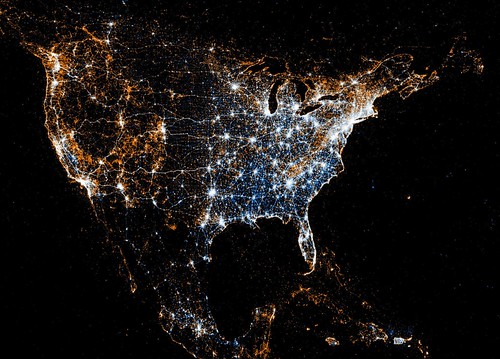Change is in the air, and most people can tell. The economy has undergone some serious disruptions. Marketers are starting to say that companies need to start speaking with, and actually listening to, their customers in order to survive. Protest movements, from Arab Spring to Occupy Wall Street, are popping up without central leadership. The open source movement questions the very idea of proprietary technology.
While some people think that these disruptions are temporary, others think they are signs of the future. Peggy Holman is one of these thinkers, and I share her position. In Engaging Emergence, she talks about how the new science of complexity applies to these types of organizations.
Could organic networks replace a strict chain of command? As you’ll see, it’s a definite possibility. In some places, it’s already happening.
The Interview
I’m happy to get the chance to talk to you, Peggy.
Thanks Carter. You’ve been gathering quite an interesting collection of interviews! Glad to be among them.
I’m glad you feel that way.
So your book is about embracing upheaval and finding a way to turn it into something constructive. You undoubtedly chose the title Engaging Emergence: Turning Upheaval into Opportunity
in reference to the relatively new science of complexity. Before we go into detail about your book, I’d like to hear what emergence means to you. Some of my readers have seen my post about complex adaptive systems, a closely related subject, but I’d like your perspective on it.
 Emergence is an elusive, yet exacting idea. Elusive because we use the term in everyday parlance, as in “we’ll see what emerges.” For those who study complexity, emergence has some specific (but evolving) characteristics that define it. I’ll say more in a moment.
Emergence is an elusive, yet exacting idea. Elusive because we use the term in everyday parlance, as in “we’ll see what emerges.” For those who study complexity, emergence has some specific (but evolving) characteristics that define it. I’ll say more in a moment.
First, some of the definitions I use:
The simplest and least accurate: emergence is order arising out of chaos.
More precise: Higher-order complexity from the process of self-organization. Novel, coherent structures arising through interactions between diverse entities in a system.
My favorite metaphorical definition: emergence is the learning edge of evolution.
As I delved into the scientific literature, characteristics that showed up consistently were:
Radical novelty—At each level of complexity, entirely new properties appear—for example, from autocracy (rule by one person with unlimited power) to democracy (people as the ultimate source of political power).
Coherence—A stable system of interactions (for example, elephant, biosphere, agreement).
Wholeness—Not just the sum of its parts, but also different and irreducible from its parts (for example, humans are more than the composition of lots of cells).
Dynamic—Always changing, continuing to evolve (for example, changes in transportation: walking, horse and buggy, autos, trains, buses, airplanes, and so on).
Downward causation—The system shapes the behavior of the parts (for example, roads determine where we drive).
 I thought the following aspects of emergence cited by scientists were most helpful in understanding how to work with social emergence:
I thought the following aspects of emergence cited by scientists were most helpful in understanding how to work with social emergence:
Situational leadership arising in context. This is often characterized as no one being in charge. I just find that so misleading! It’s just as easily thought of as everyone being in charge. In fact, the energy of the situation and of the interacting people is in charge.
Simple rules engender complex behavior. Randomness becomes coherent as individuals, each following a few basic principles or assumptions, interact with their neighbors.
Feedback among neighboring agents. Interactions that reinforce and balance the system. Feedback loops encourage or discourage action in the same general direction. They are called vicious or virtuous cycles, depending on the direction they are headed. Balancing feedback loops are opposing forces responding, as needed, to counter each other. This creates a dynamic yet stable state.
As our current assumptions of how things work break down, I think we can break through to a higher-order of human functioning.
As our current assumptions of how things work break down, I think we can break through to a higher-order of human functioning.
Clustering as like finds like. Diverse agents interact, feeding back to each other. Some individual agents bond around a shared characteristic. This forms more complex systems, such as networks, over time.
These aspects of emergence helped me make sense of behavior I saw in organizations I worked with. They help us work with emergence in human systems. I was trying to understand the essential principles behind emergent processes like Open Space Technology, Appreciative Inquiry, Future Search, the World Café and others. I figured if more of us understood how to engage with people different than ourselves, we’d all be better off and get better results. As our current assumptions of how things work break down, I think we can break through to a higher-order of human functioning. This depends on an understanding of how to work with emergence.
This is a great answer. I think it draws attention not just to what emergence is, but to how flexible its definition is. Basically, what you are saying is that emergence occurs when the interactions between simple parts and their environment creates something adaptive. This adaptation comes from feedback between the parts, the environment, and the system as a whole.
Of course, complex systems don’t always result in emergent behavior. Emergence isn’t a mystical force that takes over any complex system. Most complex systems are just nonlinear and highly unpredictable. The perfect example is the weather. By now most people have heard of the butterfly effect, where a tiny change in starting conditions results in dramatic changes down the road. What separates a chaotic system from an adaptive one? Both are complex, and to a certain degree they are both unpredictable. The key difference is that one is stable and constructive while the other is not. Why?
 Challenging question! Since my focus has been on what the science of emergence can teach us about working with social systems, I’m going to respond to your question from that perspective.
Challenging question! Since my focus has been on what the science of emergence can teach us about working with social systems, I’m going to respond to your question from that perspective.
I’d say what distinguishes a chaotic social system from an adaptive one is intention and cohesion. In other words, both a “doing” and a “being” aspect assist human systems in adapting.
Groups generally form around a shared purpose. This offers direction without necessarily explaining how to meet the intention. Think of any new work team you’ve been part of. You know why you’re there but may not know much else. If the interactions are adaptive, the purpose gets clearer and the relationships evolve.
So what contributes to productive interactions?
Good intentions alone won’t necessarily lead to adaptation. That’s where cohesion comes in. What sort of relationships can the group cultivate? I am not asking about the initial relationships. I believe adaptation requires the diverse group to discover interconnections that weave them into a larger whole, but it doesn’t need to start this way.
As you’ve already mentioned, initial conditions matter…This is why being welcoming is so essential.
As you’ve already mentioned, initial conditions matter…This is why being welcoming is so essential.
As you’ve already mentioned, initial conditions matter. How people come together matters. This is why being welcoming is so essential. It sets a social system up for success. And when the messiness of differences do arise, the work of welcoming contributes to the capacity to adapt. On the flip side, when everyone is too polite, the system is too stable. And that is as unproductive as a chaotic system.
Both intention and cohesion evolve as a group interacts. Continually clarifying intentions and deepening understanding brings stability to a social system. Of course, the ability to welcome disruptions if the system becomes too stable also helps.
I’ve come to think of leadership for emergence as stewarding shared intention and tending to the social fabric – work that can be done by anyone involved.
If I can take what you’re saying in a more general context, it sounds like you’re saying feedback is the most crucial aspect of an emergent system. Everybody needs to be aware of what the intentions are, and people need to understand the behavior of those around them, as well as the environment. Without this feedback from the environment, the people around them, and the results of their actions as a group, their efforts won’t lead anywhere productive.
You’ve also spoken a bit about the importance of randomness. What is the importance of randomness, and how do you suggest it should be dealt with?
 Randomness is essential to creativity. If everything is predictable, then all we ever experience is what we already expect. Randomness brings mystery into the equation, something not yet considered, something that disrupts the status quo.
Randomness is essential to creativity. If everything is predictable, then all we ever experience is what we already expect. Randomness brings mystery into the equation, something not yet considered, something that disrupts the status quo.
I stumbled into this notion when working with a telecommunications company years ago. I was asked to figure out how to improve knowledge transfer between departments. I started by studying successful examples of how ideas spread. One of the most intriguing discoveries was that every example involved some chance encounter. I reached the conclusion that since the unpredictable was essential, it was important to design opportunities for random encounters into the work.
That was before I ran into the social technologies I mentioned earlier. The knowledge transfer research helped me recognize the brilliance of processes like Open Space Technology, Appreciative Inquiry, Future Search, and others. I could see that they had random encounters designed into them.
It’s interesting you should mention that. If I can point to another example, there is a striking difference between the culture of suburbia and that of old city centers. They seem more alive. I think I can attribute this to the fact that one was designed around pedestrians, the other around cars. Pedestrians bump into each other and exchange information in random encounters. Cars don’t.
Anyway, this is all interesting from an academic viewpoint, but there will always be those who ask what the practical applications are. So how can we use this knowledge to improve existing systems?
As I listen to the struggles of people in traditional organizations and communities, I find that assumptions about the way things work are breaking down, creating angst. For example, when I was working on Engaging Emergence, I asked a group of people in book publishing what assumptions no longer applied. Without missing a beat, the publisher said, “the assumption that people read books.” Talk about fundamental! I could repeat that story for many industries and communities. For example, assuming your neighbors have similar life experiences is no longer something to take for granted.
So one place to start improving systems with this knowledge is by realizing that all change starts with disturbance.
So one place to start improving systems with this knowledge is by realizing that all change starts with disturbance.
So one place to start improving systems with this knowledge is by realizing that all change starts with disturbance. After all, if there were no disruptions, there would be no need for change. Once we recognize that truth, we can start developing a different relationship with disruption. We can get curious about it. Or think of it as the system letting us know that some aspect of itself needs to change.
This insight can be life changing because it opens the way to new attitudes and actions when facing disruptions.
That said, since people are always asking for the simple list of how to work with emergence, I’ve been playing with an answer. Here goes:
Be welcoming. Initial conditions matter. By setting the stage physically, emotionally, and psychically to send cues that there’s room for who and what shows up, it is more likely to happen productively.
Ask possibility oriented questions. Great questions create fertile conditions for emergence. In a sense, they bound the space, providing just enough stability for experimentation. They focus intentions, attract those who care, and imply an invitation because such questions are ones in which the asker doesn’t have the answer and knows she or he can’t find it alone.
 Invite diversity. If the same old mix of people come together in the same old way, it’s likely they’ll get the same old answers. By creating interactions that support the expression of differences, we discover the solutions that can make a difference. Often people suppress differences for fear of being rejected. That’s why welcoming conditions are so important. It may be messy, but compassion, creativity, and wisdom are more likely to show up when differences are honored.
Invite diversity. If the same old mix of people come together in the same old way, it’s likely they’ll get the same old answers. By creating interactions that support the expression of differences, we discover the solutions that can make a difference. Often people suppress differences for fear of being rejected. That’s why welcoming conditions are so important. It may be messy, but compassion, creativity, and wisdom are more likely to show up when differences are honored.
Create conditions for people to participate fully and connect with others. This is a mouthful. And it’s where those wonderful social technologies have so much to offer. They make space for lots of random interactions in which people can express what matters to them. Such spaces draw us out, inspiring us to act from places deeper than our egos. They draw from our common human yearnings. What’s remarkable is that people discover over and over that pursuing what matters to them becomes an act of service to the larger whole.
Reflect together. By making meaning of our experiences, coherence emerges. We discover we are part of a larger whole. When that happens, something changes. We emerge as a social body, willing to work together.
I think these are all great pieces of advice. For some, it might also sound like a threat to the way things have been done in the past. If emergence contrasts with the traditional belief that reductionism can explain all phenomena, what core assumptions about organizational structures are being challenged?
Where to begin? While there are many tracks for pursuing your question, I’ll focus on a shift in organizing metaphors.
For too long command and control, also known as hierarchies, has been our foundational organizing metaphor for how humans get stuff done. I think we’ve done it for so long that many assume that’s the only metaphor that works.
 I think that particular metaphor is waning in usefulness. On the rise: networks. They have much to teach us about organizational structures that deal effectively and efficiently with changing circumstances. Bees, ants, and many human emergent phenomenon, like traffic flows, are resilience in operation.
I think that particular metaphor is waning in usefulness. On the rise: networks. They have much to teach us about organizational structures that deal effectively and efficiently with changing circumstances. Bees, ants, and many human emergent phenomenon, like traffic flows, are resilience in operation.
I want to put this shift from hierarchies to networks as a dominant metaphor for organizing in perspective. Years ago, I read Howard Zinn’s A People’s History of the United States. I found it fascinating and depressing. It seemed that every time ordinary people triumphed, they were put back in their place by the powerful few. And yet, when I stepped back from the book, I was filled with hope. What I noticed was that over the long haul, social systems have been moving towards increasing numbers of people having a say over their own lives. As an organizing form, networks support more people in having that say.
I think we’ll look back on much of today’s upheaval and see our change [from hierarchies to networks] as a big part of the turmoil.
I think we’ll look back on much of today’s upheaval and see our change [from hierarchies to networks] as a big part of the turmoil.
And technology has enabled us to grow our capacity to operate through networks. A generation ago, it took a lot more work, often done by a handful of people to co-ordinate our activities. Command and control made sense given the state of our technology. Today, our technologies give us tremendous flexibility. We can be far more imprecise and adapt to whatever situations face us in the moment. I think we’ll look back on much of today’s upheaval and see our change in core organizing metaphor as a big part of the turmoil.
I think finding our way through that turmoil is in part about learning the skills that help us navigate networks. Since the fundamental dynamics of networks have to do with links connecting and hubs coalescing, that’s an area for increasing development. For example, what is the role of a leader in a hub? What does link leadership look like?
I absolutely agree with your perspective on this. While capitalism has always emphasized decentralized control, the internal structure of many businesses actually looks more like a dictatorship. The knowledge that networks themselves can offer leadership solutions is striking, but I think it has the potential to improve not only business, but the human experience itself. Can we create or alter existing systems so that they become more adaptive and better at embracing change?
Such an important question! To what extent will existing systems survive? Emergence involves both death and re-birth. I have done a lot of work with journalists. Being witness to a social system going through a radical re-invention has been instructive and made me more compassionate.
Meg Wheatley has a phrase that I think beautifully describes what so many systems are experiencing: we’re hospicing the old and mid-wiving the new. Ultimately existing systems will adapt or die.
I agree. What would these systems look like? Are there working examples already in place?
 I think many examples are all around us. The Open Source movement and Wikipedia are examples of where organizational forms are heading. What’s happening with the Occupy movement is terrifically exciting to me. I’m watching these groups experiment with patterns of organizing that maximize individual freedom while providing an essential core of connectedness.
I think many examples are all around us. The Open Source movement and Wikipedia are examples of where organizational forms are heading. What’s happening with the Occupy movement is terrifically exciting to me. I’m watching these groups experiment with patterns of organizing that maximize individual freedom while providing an essential core of connectedness.
I haven’t dived deeply into describing these systems. That said, some of my observations are:
1. They are self-organizing, inviting people to take responsibility for what matters to them, while being of service to the whole
2. They are possibility-oriented, with a spirit of appreciation
3. Questions are as important as answers, providing direction and a spirit of invitation
4. They are open to messiness, recognizing disruptions as doorways to opportunity
5. They are diverse, able to engage differences creatively
6. They are ultimately compassionate. While that doesn’t mean every moment is always sweetness and light, they make room for human failings and learning.
My list is far from complete. It is in that expansive stage that things will get messier before they ultimately coalesce into a handful of essential characteristics. And that will happen on another day.
Thanks for your questions.
You have offered some compelling answers, Peggy.
Sobriety Programs, the Educational System, and a Deadly Icicle of Doom